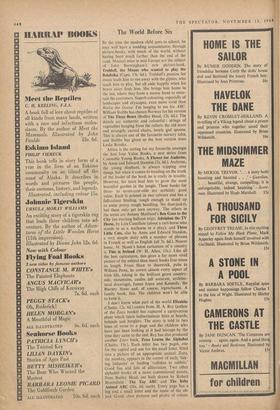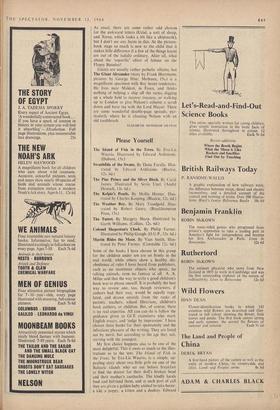The World Before Six
BY the time the modern child goes to school, he may well have a nodding acquaintance, through
picture-books, with much of the world, without having been much farther than the end of the road. Musical mice in mid-Europe are the subject of John Burningham's new picture-book, Trubloff, the Mouse who wanted to play the Balalaika (Cape, 13s. 6d.). Trubloff's passion for music leads him to run away with the gipsies, who teach him to play, but all ends happily when his brave sister finds him. She brings him home to
the inn, where they form a mouse band to enter- tain the customers. Superb colouring, especially of landscapes and skyscapes, even more vivid than Borka the Goose. I'm longing to see his ABC. William Stobbs has chosen Norway for his version of The Three Bears (Bodley Head, 12s. 6d.). The details are authentic and colourful : strings of vegetables hanging from the rafters, the old stove and strangely carved chairs, bowls 4nd spoons. This is always one of the favourite nursery tales, and Stubbs has given us the best version since Leslie Brooke.
Africa is the setting for my favourite amongst the first four Value Books, a new series from Constable Young Books, A Flower for Ambrose, by Anna and Edward Standon (7s. 6d.). Ambrose, the young elephant, is always tripping over things, but when it comes to treading on the trunk of the leader of the herd, he is really in trouble. However, his tears lead him to grow the most beautiful garden in the jungle. These books for three- to seven-year-olds are certainly good value. Each is printed in two colours and has a full-colour binding, tough enough to stand up to some pretty rough handling. No dust-jacket, but these only get torn anyway. The others in the series are Antony Maitland's Ben Goes to the City (an exciting balloon trip); Adolphus the TV Horse, by Lois Castellain (about a cart-horse who stands in as a warhorse in a play); and Three Little Cats, also by Anna and Edward Standon, a very simple story with a number of phrases in French as well as English (all 7s. 6d.). Nearer home, M. Slasek's latest caricature of a country is This is Ireland (W. H. Allen, 15s.). Like all the best caricatures, this gives a far more vivid picture of the subject than many books four times its length. From Shaw to shamrock, pubs to William Penn, he covers almost every aspect of Irish life, taking in the brilliant green country- side, mountains, castles (all accurate, architec- tural drawings), James Joyce and Kennedy, the Blarney Stone and, of course, leprechauns. A family book, this. The children won't be able to keep it.
I don't know what part of the world Elizabite (Chatto, 12s. 6d.) comes from. H. A. Rey (author of the Zozo books) has captured a carnivorous plant which takes indiscriminate bites at beards, behinds and burglars. The story is told in two lines of verse to a page and the children who have just been looking at it had hiccups by the time they came to the end. Rey has also produced another Zozo book, Zozo Learns the Alphabet (Chatto, 15s.). Each letter has two pages, one for the capital and one for the small letter, fitted into a picture of an appropriate animal. Zozo, the monkey, appears in the corner of each, 'lick- ing lollipops' or feeding 'radishes to rabbits.' Good fun and lots of alliteration. Two other alphabet books of a more conventional nature, from Bodley Head, are both drawn by Robert Broomfield : The Toy ABC and The Baby Animal ABC (10s, 6d. each). Every page has a big and a small letter and the name of the ob- ject. Good, clear pictures and plenty of colour As usual, there are some rather odd choices for the awkward letters (Urial, a sort of sheep, and Xerus, which looks a bit like a chipmunk), but I don't see any harm in this. At the picture- book stage so much is new to the child that it makes little difference if a few of the things learnt are out of the (adult) ordinary. After all, what about the 'soporific' effect of lettuce on the Flopsy Bunnies?
Giants are usually rather pathetic villains, but The Giant Alexander (story by Frank Herrmann; pictures by George Him; Methuen, 15s.) is a magnificent specimen with Boy Scout tendencies. He lives near Maldon, in Essex, and thinks nothing of helping a ship off the rocks, digging up a whole field to recover treasure, or walking up to London to give Nelson's column a scrub down and have tea with the Lord Mayor. There are some wonderful double-page spreads, par- ticularly where he is cleaning Nelson with an old toothbrush.
ELIZABETH HENNIKER HEAtoN











































 Previous page
Previous page